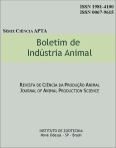Pererinnial soybean (Glycine wightii Verdc.) introduction into pasture predominantly formed with molasses grass (Melinis minutíflora Pal. de Beauv.)
Abstract
The present experiment was carried out at Estação Experimental Central of the Instituto de Zootecnia, in Nova Odessa, State of São Paulo, from April to December of 1979. It was studied three introduction sysiems of perennial soybean (Glycine wightii Verdc.) mio molasses grass (Melinis minutifiora Pal de Beauv.) established pasture: A) Grazinq by animals and broadcast sowing; B) Cut by scythe. harrowing and broadcast sowing; C) Association of grazing by animals and cui by scythe, harrowing and broadcast sowing. It was compared also two sowing densities (3.5 and 6.5kg/ha). After sowing, it was maintened animals on the experimental area, for seven days to burry the seeds into the soil. Both the grazing by animals and the cut by scythe, before sowing, lowered me forage to a height of 10 to 20cm and the harvested material was left on the experimental plots (in, treatments B and C). The introduction methods, in which machines were used (B and C) allowed the maintenante of a greater number of perennial soybean per square meter than the method using animals only (A). The highest sowing density (6.5kgil,a) resulted in the greatest number of perennial soybean plants per area. The legume populations were higher in the Autumn (time of sowing) than in the Winter but increased again in the Spring, probably because of the germination of hard seeds that had not germinated at sowing time.Downloads
Downloads
Published
Issue
Section
License
Os autores não serão remunerados pela publicação de trabalhos, pois devem abrir mão de seus direitos autorais em favor deste periódico. Por outro lado, os autores ficam autorizados a publicar seus artigos, simultaneamente, em repositórios da instituição de sua origem, desde que citada a fonte da publicação original seja Boletim de Indústria Animal. A revista se reserva o direito de efetuar, nos originais, alterações de ordem normativa, ortográfica e gramatical, com vistas a manter o padrão culto da língua e a credibilidade do veículo. Respeitará, no entanto, o estilo de escrever dos autores. Alterações, correções ou sugestões de ordem conceitual serão encaminhadas aos autores, quando necessário. Nesses casos, os artigos, depois de adequados, deverão ser submetidos a nova apreciação. As opiniões emitidas pelos autores dos artigos são de sua exclusiva responsabilidade. Todo o conteúdo deste periódico, exceto onde está identificado, está licenciado sob a Licença Creative Commons Attribution (CC-BY-NC). A condição BY implica que os licenciados podem copiar, distribuir, exibir e executar a obra e fazer trabalhos derivados com base em que só se dão o autor ou licenciante os créditos na forma especificada por estes. A cláusula NC significa que os licenciados podem copiar, distribuir, exibir e executar a obra e fazer trabalhos derivados com base apenas para fins não comerciais.













